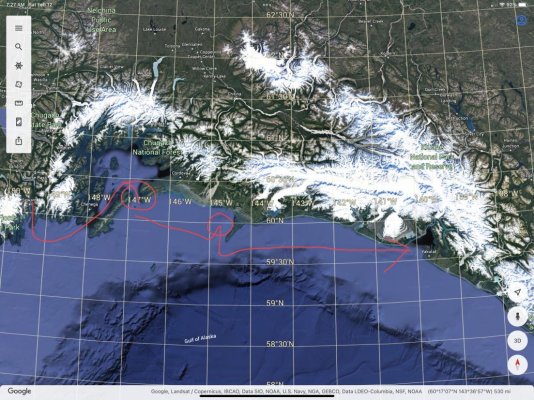ksanders
Moderator Emeritus
In less than 90 days I will leave my home port in Seward Alaska.
The first leg of this journey is the longest one, crossing the gulf of Alaska.
This is a solo trip I am making.
The total distance is 330NM that I need to travel from my home port in Seward Alaska to the community of Yakutat where I can take on fuel.
The first leg will be around 110NM from seward to In between the two islands in the photo. This is either one long day or two easy days. No problem there.
The second leg is 220NM across the gulf.
The challenge is how to accomplish that safely with just me on board.
Here are the particulars of my boat....
440 gallons of fuel
I can travel at 8 knots and get around 1.75NMPG I like to do my planning at 1.5NMPG though just to be on the safe side.
So... on the first leg I will burn around 75 gallons of fuel
The 2nd leg of 220NM is the challenge.
If I attempt that leg at 8 knots then I will be 27 hours awake. That is dangerous.
I might, and the big word hereis might be able to anchor behind the little island you see with a circle in the photo. The word might is because this is a very tricky spot, with poor chart reliability, and needing local knowledge. I am a bit aprehensive.
I could travel at my thoeretical hull speed of 9 knots and get around 1.3 nmpg and the trip would take 24 hours
Another option would be to go 10 knots for that leg With my Water line length of 44' that speed is pushing a big bow wave but the boat is not starting to noticiable lift in the bow. My fuel economy at that speed drops to about 1.0 nmpg That would shorten the trip to 22 hours
The other option would be to hit the throttles and go. Up on plane, 15 knots. Then the trip would be around 15 hours. but my economy goes to about .75NMPG If I choose this I will bring some fuel drums and top off the tanks before this leg just to be sure. The risk of this is hitting a log and stress. Up on plane is stressful. Things happen fast, and there are logs to avoid. Up on plane also means that I if I hit a log it will pull under the boat as opposed to flat and level.
Now a bit about me and my body.
Currently as part of my job I am required to change shifts frequently with little notice. That means that I often have to stay up 24 hours and be fully functional in life and death safety situations. This is something I am accustomed to and have trained my body to do. That career ends just a couple days before this departure.
So now the big question, what would you do?
The first leg of this journey is the longest one, crossing the gulf of Alaska.
This is a solo trip I am making.
The total distance is 330NM that I need to travel from my home port in Seward Alaska to the community of Yakutat where I can take on fuel.
The first leg will be around 110NM from seward to In between the two islands in the photo. This is either one long day or two easy days. No problem there.
The second leg is 220NM across the gulf.
The challenge is how to accomplish that safely with just me on board.
Here are the particulars of my boat....
440 gallons of fuel
I can travel at 8 knots and get around 1.75NMPG I like to do my planning at 1.5NMPG though just to be on the safe side.
So... on the first leg I will burn around 75 gallons of fuel
The 2nd leg of 220NM is the challenge.
If I attempt that leg at 8 knots then I will be 27 hours awake. That is dangerous.
I might, and the big word hereis might be able to anchor behind the little island you see with a circle in the photo. The word might is because this is a very tricky spot, with poor chart reliability, and needing local knowledge. I am a bit aprehensive.
I could travel at my thoeretical hull speed of 9 knots and get around 1.3 nmpg and the trip would take 24 hours
Another option would be to go 10 knots for that leg With my Water line length of 44' that speed is pushing a big bow wave but the boat is not starting to noticiable lift in the bow. My fuel economy at that speed drops to about 1.0 nmpg That would shorten the trip to 22 hours
The other option would be to hit the throttles and go. Up on plane, 15 knots. Then the trip would be around 15 hours. but my economy goes to about .75NMPG If I choose this I will bring some fuel drums and top off the tanks before this leg just to be sure. The risk of this is hitting a log and stress. Up on plane is stressful. Things happen fast, and there are logs to avoid. Up on plane also means that I if I hit a log it will pull under the boat as opposed to flat and level.
Now a bit about me and my body.
Currently as part of my job I am required to change shifts frequently with little notice. That means that I often have to stay up 24 hours and be fully functional in life and death safety situations. This is something I am accustomed to and have trained my body to do. That career ends just a couple days before this departure.
So now the big question, what would you do?

